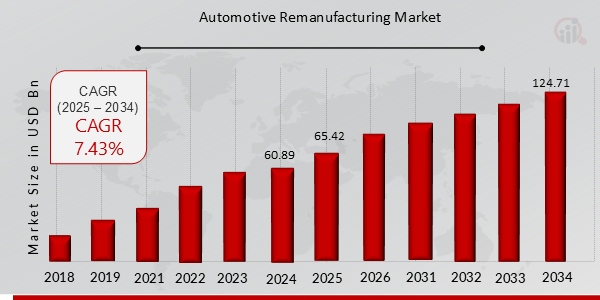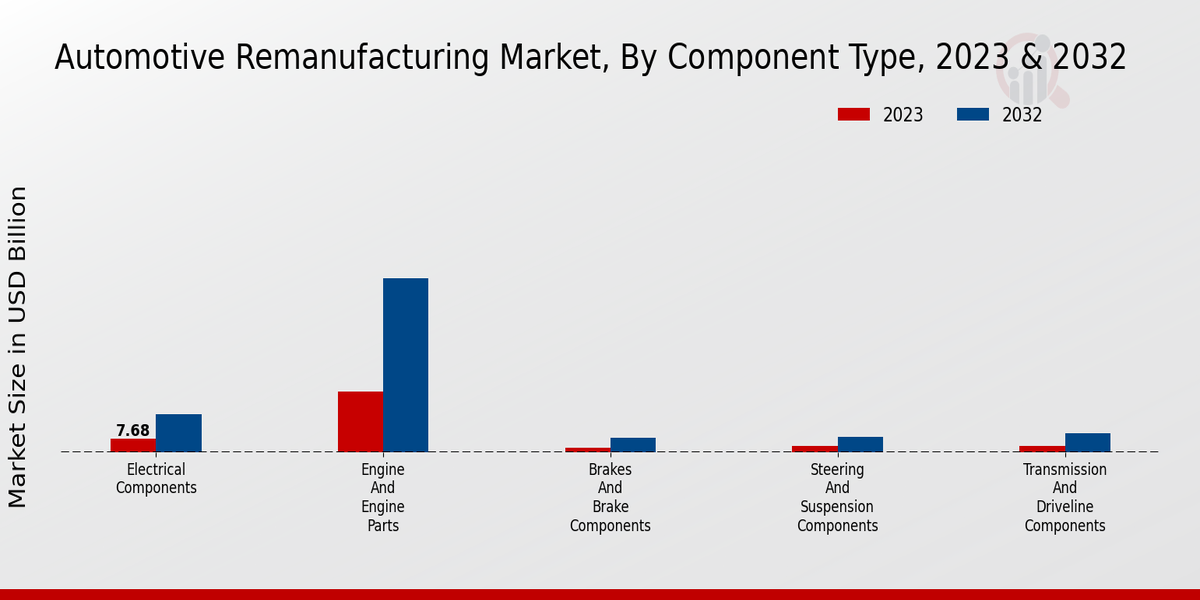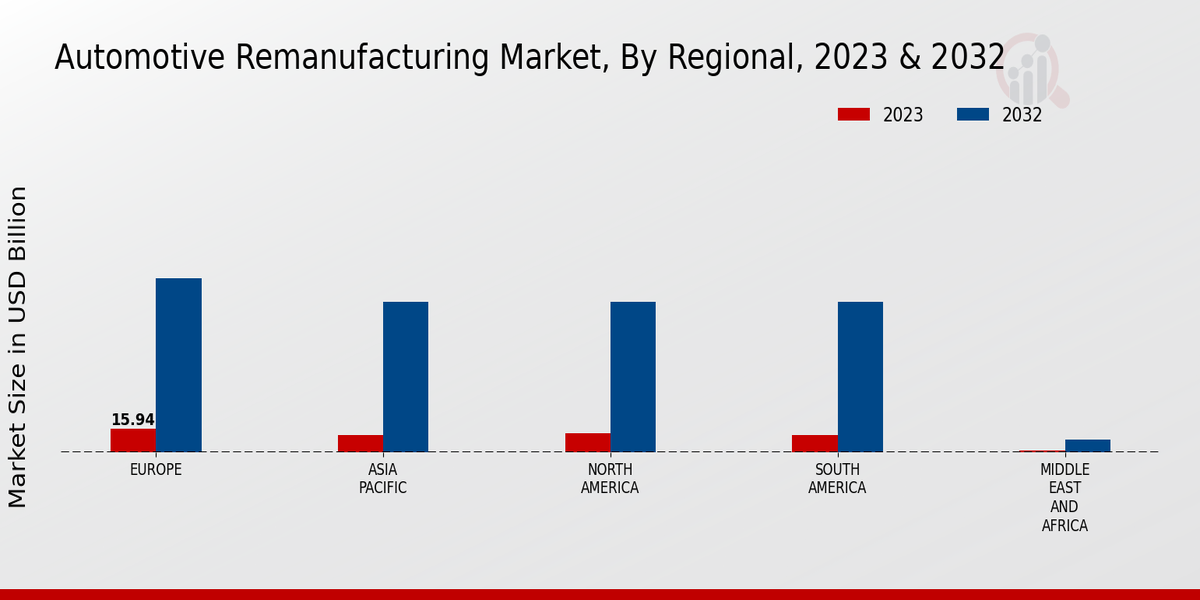Global Automotive Remanufacturing Market Overview
As per MRFR analysis, the Automotive Remanufacturing Market Size was estimated at 60.89 (USD Billion) in 2024. The Automotive Remanufacturing Market Industry is expected to grow from 65.42 (USD Billion) in 2025 to 124.71 (USD Billion) till 2034, at a CAGR (growth rate) is expected to be around 7.43% during the forecast period (2025 - 2034).
Key Automotive Remanufacturing Market Trends Highlighted
The automotive remanufacturing market is rapidly expanding driven by rising environmental concerns, technological advancements, and cost-effectiveness. Stringent emission regulations and consumer demand for sustainable solutions are promoting the adoption of remanufactured auto parts. Additionally, advances in remanufacturing techniques have improved the quality and reliability of remanufactured components, making them viable alternatives to new parts. The increasing cost of new auto parts has also made remanufacturing a more attractive option for consumers seeking affordable repairs and maintenance.
Key market drivers include government incentives for sustainable practices, growing awareness of the environmental impact of vehicle manufacturing, and technological advancements in remanufacturing processes. Opportunities to be explored include the expansion of remanufacturing capabilities for electric vehicles, the development of new materials and technologies, and the establishment of partnerships between automakers and remanufacturing companies. Recent trends include the integration of digital technologies into remanufacturing processes, the adoption of artificial intelligence for quality control, and the emergence of remanufacturing-as-a-service business models.

Source: Primary Research, Secondary Research, MRFR Database and Analyst Review
Automotive Remanufacturing Market Drivers
Rising Environmental Concerns
The automotive industry is one of the main sources of pollution in the world, and remanufacturing the used components is the only proper way to reduce the environmental load that it produces. It implies bringing the used part into its original condition and extending its term. It also allows saving resources, as it gives the opportunity to use the old and not carry out production of new components. The process of remanufacturing consumes significantly less energy and produces less greenhouse gasses and waste in landfills.The environmentally-friendly trend and increasing number of environmentally conscious customers make the demand for remanufactured automotive parts grow all over the world.
Technological Advancements
The process of remanufacturing has also become more efficient, affordable, and accurate when it comes to producing new parts from the comparison perspective. At the same time, it would be possible to ensure superior benefits in terms of cost and quality as the use of new advanced technologies was proved to allow for a higher level of precision and requirements. Moreover, the produced new parts will continue to function properly. These are the reasons why the abovementioned technological insights are beneficial for the development of new parts and for improving the process of remanufacturing.
Government Regulations and Incentives
Government regulations and incentives are also fu important for business and the factors contributing to the growth of this industry. In many countries, policy actions work towards creating a favorable environment to promote the use of remanufactured parts by car owners, and it includes tax brakes, subsidies, and public procurement policies. These create incentives for businesses and final consumers to buy remanufactured rather than new parts. The advantage of remanufacturing sop that it meets stricter environmental regulations.Remanufacturing is attractive to manufacturers and suppliers whose businesses will conform to the environmental protection and sustainability regime.
Automotive Remanufacturing Market Segment Insights:
Automotive Remanufacturing Market Component Type Insights
The Automotive Remanufacturing Market segmentation by Component Type is beneficial to understand the inner structure and dynamics of the industry. As is seen from the table, the most influential ones are the Engine and Engine Parts segments, which will continue to be the leader over the forecast period. These are cost-effective and environmentally friendly products that are in high demand. Transmission and Driveline Components are also expected to be popular as more and more automated and electrical cars are implemented, thus creating a constant demand for specific transmission and driveline systems.
Steering and Suspension Components made a significant contribution to the Automotive Remanufacturing Market and will be in certain demand for some time; it is primarily explained by the growing interest in safety issues among manufacturers and the increasingly strict requirements for vehicle emissions. As for Brakes and Brake Components, it is also an important vehicle part that provides a decent outlook for this segment due to the heavier traffic and the demand for new and advanced systems. Finally, Electrical Components are projected to develop at an extreme pace in the future, mostly due to the increasing amount of electronic engines and other related systems, such as alternators, starters, and wiring harnesses.
The commercial presence of electrical and especially hybrid cars also fuels this tendency. This market is quite competitive; there are a lot of experienced companies and numerous beginners. They focus on the broadening of the product range, the increasing capacity of remanufacturing, and the general attempts to be closer to the world’s internationally accepted standards for being able to receive a part of the big and constantly shedding market.

Source: Primary Research, Secondary Research, MRFR Database and Analyst Review
Automotive Remanufacturing Market Vehicle Type Insights
The Automotive Remanufacturing Market is divided into Vehicle Type: Passenger Cars, Light Commercial Vehicles, Heavy Commercial Vehicles, Construction Equipment, and Agricultural Equipment. Passenger Cars are the ruling segment and hold the largest market share. This is due to the increasing demand for passenger cars' remanufactured components, which are cost-effective and provide environmental benefits. Light Commercial Vehicles are also anticipated to increase significantly, as it is widely used in various industries. The growth of remanufactured components in Heavy Commercial Vehicles and Construction Equipment is increasing, and the market is also expected to show significant growth.The Agricultural Equipment segment is expected to show decent growth by exhibiting a significant International Automotive Remanufacturing Market over the foreseeable timeline.
Automotive Remanufacturing Market End-User Industry Insights
The Automotive Remanufacturing Market is segmented by End-User Industry into Automotive OEM, Automotive Aftermarket, Industrial Equipment, Military and Defense, and Energy and Utilities. Among these segments, the Automotive Aftermarket is projected to hold the largest market share during the forecast period, owing to the increasing demand for cost-effective and environmentally friendly automotive parts. The Automotive OEM segment is also expected to witness significant growth, driven by the rising production of new vehicles and the need for efficient and reliable components.
The Industrial Equipment segment is anticipated to show steady growth, supported by the growing demand for remanufactured equipment in various industries such as construction, mining, and agriculture. The Military and Defense segment is expected to experience moderate growth due to the increasing investment in defense and military equipment. The Energy and Utilities segment is projected to have a moderate growth rate, driven by the growing demand for remanufactured components in power generation, transmission, and distribution systems.
Automotive Remanufacturing Market Remanufacturing Process Insights
The automotive remanufacturing process involves several key steps, each playing a crucial role in ensuring the quality and performance of the remanufactured component. The core collection is the initial stage, where used or end-of-life components are collected from various sources, such as repair shops, salvage yards, and vehicle owners. These cores serve as the foundation for the remanufacturing process. Disassembly and inspection follow a core collection, where the components are meticulously dismantled into their individual parts.
Each part is thoroughly inspected to assess its condition and identify any damage or wear.Cleaning and repair are the subsequent steps, where the parts are meticulously cleaned to remove contaminants and impurities. Damaged or worn parts are repaired or replaced using specialized techniques and equipment to restore their functionality. Reassembly and testing are crucial steps in the remanufacturing process. The cleaned and repaired parts are reassembled with precision and care, ensuring that they meet the original specifications and performance standards.
Rigorous testing is conducted to verify the functionality and reliability of the remanufactured components before they are released for distribution.Finally, quality assurance plays a vital role in ensuring the integrity and reliability of the remanufactured components. This involves stringent quality control measures throughout the entire remanufacturing process, from core collection to final testing. By adhering to industry standards and best practices, manufacturers can ensure that remanufactured components meet or exceed the performance and durability of new components.
Automotive Remanufacturing Market Distribution Channel Insights
The distribution channel segment plays a crucial role in the Automotive Remanufacturing Market, influencing market growth and revenue generation. Direct OEM Distribution holds a significant share of the market, as Original Equipment Manufacturers (OEMs) leverage their established distribution networks and customer relationships. Independent Distributors also have a strong presence, offering a wide range of remanufactured automotive parts to repair shops and end-users.
Online Marketplaces are gaining traction, providing convenience and access to a broader customer base.Retail Stores cater to walk-in customers, offering a more personalized shopping experience. Fleet Management Companies represent a growing segment as they seek cost-effective solutions for maintaining their vehicle fleets. The Automotive Remanufacturing Market is expected to witness significant growth in the coming years, driven by factors such as increasing vehicle production, rising demand for sustainable practices, and technological advancements.
Automotive Remanufacturing Market Regional Insights
The Automotive Remanufacturing Market is segmented into North America, Europe, APAC, South America, and MEA. The market in North America is expected to hold the largest share due to the presence of major automotive manufacturers and a well-established aftermarket industry.
Europe is another major market for automotive remanufacturing, driven by stringent environmental regulations and a focus on sustainability. The APAC region is expected to witness significant growth due to the increasing production and sales of vehicles, particularly in China and India.South America and MEA are emerging markets with growth potential driven by government initiatives and increasing vehicle ownership rates.

Source: Primary Research, Secondary Research, MRFR Database and Analyst Review
Automotive Remanufacturing Market Key Players And Competitive Insights:
Each year, major industry players in the Automotive Remanufacturing Market seek to refine and develop new technologies and strategies to maintain their competitive positions. Increasingly, leading Automotive Remanufacturing Market players are looking to expand their product portfolios and increase the geographical scope of their operations to meet the fast-growing demand for automotive remanufactured products and services.In recent years, manufacturing companies have invested significant resources into research and development of technologies that can allow for better operation and lower costs of their automotive remanufacturing product lines.
A number of important trends are now defining the Automotive Remanufacturing Market Competitive Landscape, such as the adoption of advanced manufacturing technologies, increased demand for subscription-based remanufacturing services, and the development of new business models.Cummins is a leading company in the Automotive Remanufacturing Market.
A Fortune 500 company, Cummins is a global leader in the design, production, and supply of engines, power generation systems, and complementary solutions. Cummins is also a prominent player in the automotive remanufacturing market segment. Cummins' remanufactured products include engines, transmissions, and turbochargers.The company operates on the principles of high quality and customer support. Cummins hiring policy ensures that employees working on remanufacturing products are highly experienced engineers and technicians. They devote their expertise and knowledge to making sure that the products they release to the market are the best in every sense of the word.
One of the key competitors in the Automotive Remanufacturing Market to Cummins is Caterpillar. One of the biggest corporations in the world, Caterpillar, in addition to manufacturing construction and mining equipment, engines, gas turbines, and diesel-electric locomotives, also remanufactures engines, transmissions, and axles. The company devotes the same level of resources to launching high-quality remanufactured products and services and has become a powerful rival in the Automotive Remanufacturing Market.
Key Companies in the Automotive Remanufacturing Market Include:
- ZF Friedrichshafen
- GKN Driveline
- Robert Bosch
- Mahle Gmb H
- Visteon Corporation
- LKQ Corporation
- Schaeffler Group
- BorgWarner
- Standard Motor Products
- Delphi Technologies
- Cummins
- Allison Transmission
- DENSO Corporation
- Tenneco
Automotive Remanufacturing Industry Developments
ZF Friedrichshafen
March, 2025: ZF Friedrichshafen reported a €1 billion loss for the year 2024, attributing the downturn to restructuring costs amid significant industry pressures, including weak demand and the costly transition to electric vehicles. The company has set aside €600 million for restructuring, primarily for staff reductions, and plans to cut up to 14,000 jobs in Germany by 2028.
September, 2024: ZF Aftermarket introduced the "ZF REMAN" label at Automechanika Frankfurt, emphasizing the company's commitment to sustainable automotive practices through remanufacturing. This initiative aims to enhance the visibility of remanufactured products across all ZF premium brands.
Robert Bosch GmbH
November, 2024: Bosch announced plans to reduce its automotive division workforce by up to 5,500 jobs over the coming years. The decision is driven by stagnant global auto sales, overcapacity in the industry, and a slower-than-expected shift to electric and software-controlled vehicles. Approximately half of these reductions will occur in Germany, with completion targeted by 2032.
The Automotive Remanufacturing Market is projected to reach USD 124.71 billion by 2034, exhibiting a CAGR of 7.43% from 2025 to 2034. Rising environmental concerns and government regulations promoting sustainable practices are driving market growth. Key players are focusing on expanding their product portfolios and geographical reach through strategic partnerships and acquisitions.
Recent developments include the collaboration between DENSO and Robert Bosch to establish a joint venture for automotive remanufacturing and the acquisition of Remy International by BorgWarner to strengthen its position in the global remanufacturing market.
Automotive Remanufacturing Market Segmentation Insights
Automotive Remanufacturing Market Component Type Outlook
- Engine and Engine Parts
- Transmission and Driveline Components
- Steering and Suspension Components
- Brakes and Brake Components
- Electrical Components
Automotive Remanufacturing Market Vehicle Type Outlook
- Passenger Cars
- Light Commercial Vehicles
- Heavy Commercial Vehicles
- Construction Equipment
- Agricultural Equipment
Automotive Remanufacturing Market End-User Industry Outlook
- Automotive OEM
- Automotive Aftermarket
- Industrial Equipment
- Military and Defense
- Energy and Utilities
Automotive Remanufacturing Market Remanufacturing Process Outlook
- Core Collection
- Disassembly and Inspection
- Cleaning and Repair
- Reassembly and Testing
- Quality Assurance
Automotive Remanufacturing Market Distribution Channel Outlook
- Direct OEM Distribution
- Independent Distributors
- Online Marketplaces
- Retail Stores
- Fleet Management Companies
Automotive Remanufacturing Market Regional Outlook
- North America
- Europe
- South America
- Asia Pacific
- Middle East and Africa
| Report Attribute/Metric |
Details |
|
Market Size 2024
|
60.89 (USD Billion)
|
|
Market Size 2025
|
65.42 (USD Billion)
|
|
Market Size 2034
|
124.71 (USD Billion)
|
|
Compound Annual Growth Rate (CAGR)
|
7.43% (2025 - 2034)
|
|
Report Coverage
|
Revenue Forecast, Competitive Landscape, Growth Factors, and Trends
|
|
Base Year
|
2024
|
|
Market Forecast Period
|
2025 - 2034
|
|
Historical Data
|
2019 - 2023
|
| Market Forecast Units |
USD Billion |
| Key Companies Profiled |
Caterpillar, Parker Hannifin Corporation, Denso Corporation, BorgWarner, REV Group, Cummins, Meritor, ZF Friedrichshafen, Allison Transmission, Tremec Holding, Robert Bosch, Eaton Corporation, Magna International, Hitachi Automotive, Henniges Automotive Holdings |
| Segments Covered |
Component Type, Vehicle Type, End-User Industry, Remanufacturing Process, Distribution Channel, Regional |
| Key Market Opportunities |
1 Growing demand for sustainable solutions2 Increasing adoption of circular economy models3 Government incentives for remanufacturing4 Technological advancements enhancing efficiency5 Rising cost of new automotive parts |
| Key Market Dynamics |
Rising environmental concerns Government regulations promoting sustainability Technological advancements improving remanufacturing efficiency Increasing demand from cost-conscious consumers Growing adoption by automotive manufacturers |
| Countries Covered |
North America, Europe, APAC, South America, MEA |
Frequently Asked Questions (FAQ) :
The Automotive Remanufacturing Market is expected to reach a valuation of 52.76 billion USD in 2023.
The Automotive Remanufacturing Market is expected to reach a valuation of 100.55 billion USD by 2032, growing at a CAGR of 7.43% from 2024 to 2032.
The Asia-Pacific region is expected to hold the largest market share in the Automotive Remanufacturing Market, owing to the increasing demand for remanufactured automotive components in countries like China and India.
The powertrain segment is expected to hold the largest market share in the Automotive Remanufacturing Market due to the high demand for remanufactured engines and transmissions.
Some of the key competitors in the Automotive Remanufacturing Market include: - Bosch - Delphi - Denso - Magna International - Aisin Seiki.
The key trends driving the growth of the Automotive Remanufacturing Market include: - Increasing demand for cost-effective automotive components - Growing environmental concerns - Technological advancements in remanufacturing processes.
The key challenges faced by the Automotive Remanufacturing Market include a lack of awareness about remanufactured components, Quality concerns associated with remanufactured components, and the limited availability of remanufactured components for certain vehicle models.
The key opportunities for growth in the Automotive Remanufacturing Market include: - Increasing adoption of remanufactured components by automotive manufacturers - Growing demand for remanufactured components in emerging markets - Technological advancements in remanufacturing processes.
The COVID-19 pandemic had a negative impact on the Automotive Remanufacturing Market in the short term due to disruptions in the supply chain and a decline in demand for automotive components. However, the market is expected to recover in the long term as businesses adapt to the new normal and demand for remanufactured components increases.
The key regulatory factors affecting the Automotive Remanufacturing Market include: - Environmental regulations related to the disposal of automotive components - Safety regulations related to the quality of remanufactured components - Trade regulations related to the import and export of remanufactured components.

















